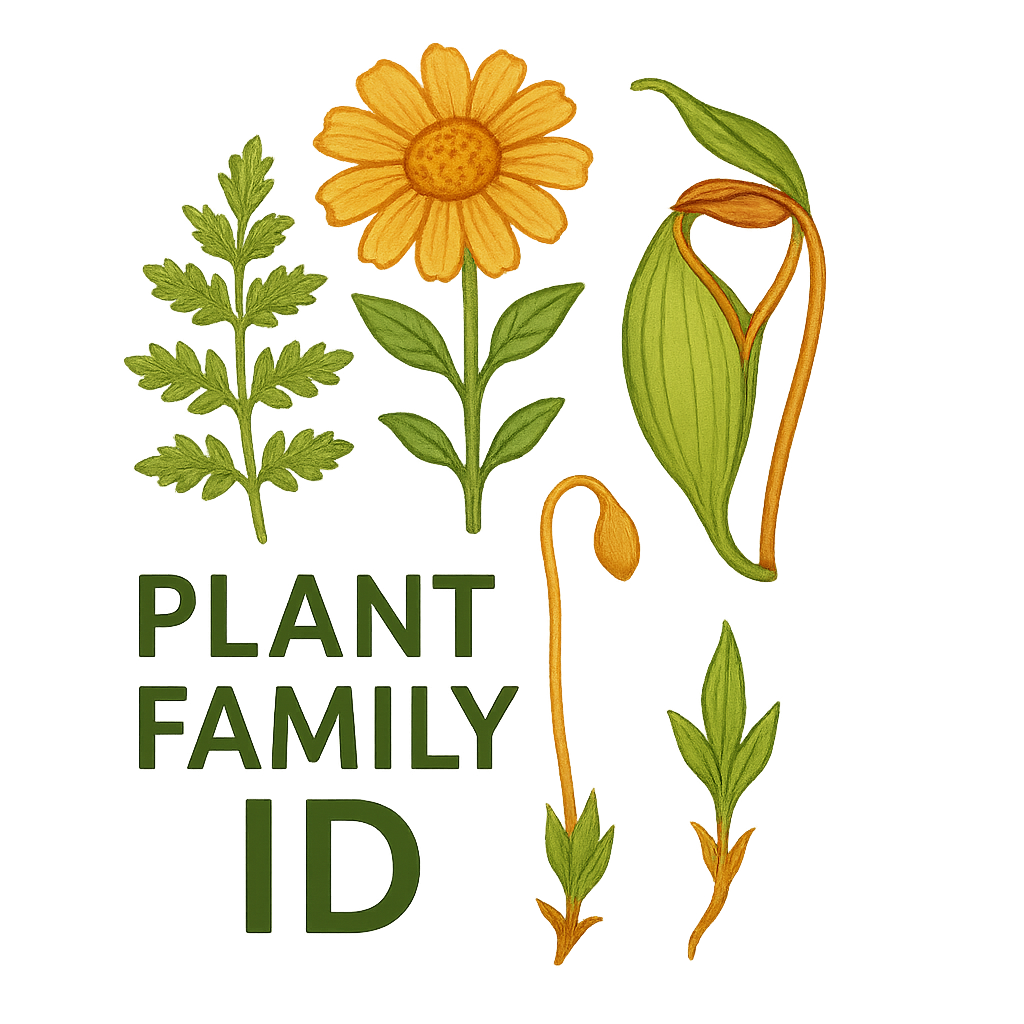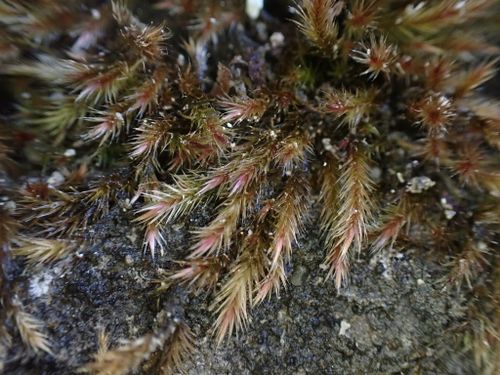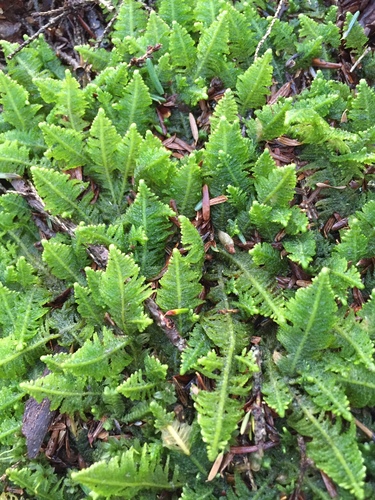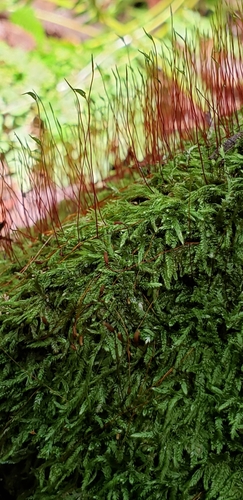Entodontaceae
Glossy Feather Moss Family (Informal)
Entodontaceae is a large, cosmopolitan family of pleurocarpous mosses belonging to the order Hypnales. The principal genus is Entodon. These mosses are typically characterized by their very glossy appearance, often flattened (complanate) shoots, concave leaves lacking a costa (or nearly so), and distinctive erect, symmetric capsules.
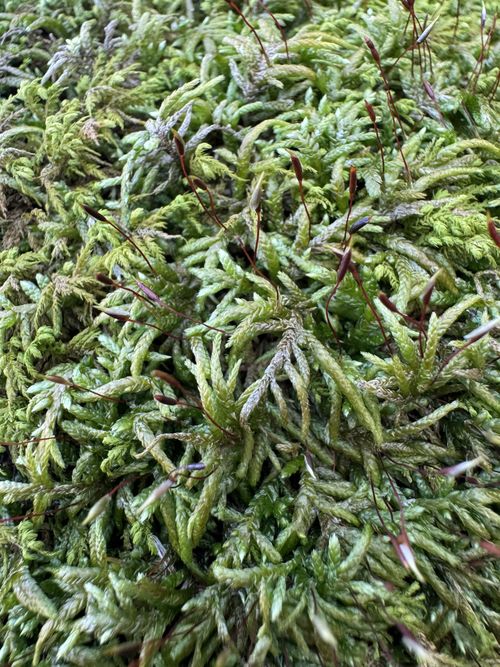
Overview
The Entodontaceae family, established by Kindberg, is a significant group of pleurocarpous mosses found nearly worldwide. The large genus Entodon forms the core of the family, which also includes several smaller genera like Erythrodontium and Mesonodon. These mosses are well-known for their often striking glossiness, frequently appearing silky smooth in shades of yellow-green, golden, or brownish-green.
Plants typically form dense, smooth mats or wefts on various substrates. The shoots are often strongly flattened (complanate), with leaves arranged neatly in one plane. Key features include the concave leaves that lack a midrib (costa) or have only a very short, faint double one, and the characteristically erect and symmetric capsules borne on long stalks (setae). The peristome structure, particularly the reduced inner peristome (endostome), is also diagnostic for the family.
Entodontaceae are ecologically versatile, growing on tree bark, decaying logs, rocks (both calcareous and acidic), and soil in forests, woodlands, and sometimes more open habitats. Their distribution is cosmopolitan, occurring in temperate and tropical regions across the globe. The family is placed within the large order Hypnales.
Quick Facts
- Scientific Name: Entodontaceae Kindb.
- Common Name: Glossy Feather Moss Family (Informal)
- Number of Genera: Several, dominated by Entodon.
- Number of Species: Numerous species worldwide, esp. in Entodon.
- Distribution: Cosmopolitan (worldwide in temperate and tropical regions).
- Evolutionary Group: Bryophytes - Mosses (Class Bryatae - Order Hypnales)
Key Characteristics (Moss Features)
Gametophyte (Leafy Plant)
The dominant stage. Plants medium-sized to robust, typically very glossy, yellowish-green to golden or brownish, pleurocarpous, forming dense, smooth mats or wefts.
- Stems: Creeping, usually pinnately or subpinnately branched. Branches often strongly complanate (flattened) and appearing smooth, sometimes julaceous when dry.
- Leaves (Phyllids): Crowded, typically appressed when dry, spreading when moist, often strongly complanate. Leaves ovate, oblong-ovate, or ovate-lanceolate, strongly concave, usually symmetric. Apex typically acute or shortly acuminate, not long-tapering. Margins usually plane or narrowly recurved at base, entire or finely serrulate near apex.
- Costa (Midrib): Characteristically absent, or very short and double at the extreme base.
- Leaf Cells: Long and narrow (linear), smooth, often with thick walls. Alar cells at the basal corners often differentiated, typically quadrate or rectangular in distinct groups, but usually not inflated or colored.
Reproductive Structures (Gametophyte)
Antheridia and archegonia are borne in lateral buds on the stems or branches.
Sporophyte (Spore-Producing Structure)
Arises laterally from the gametophyte stem. Consists of:
- Seta: Usually long, slender, smooth, often reddish or yellowish.
- Capsule (Sporangium): Characteristically erect and symmetric (or nearly so), cylindrical or ovoid-cylindrical. Operculum usually conical to long-rostrate (beaked).
Peristome
Typically double, but often with a reduced endostome. The 16 outer exostome teeth are usually well-developed, lanceolate. The inner endostome typically has a low basal membrane, narrow segments that may adhere to the exostome teeth, and rudimentary or absent cilia. This reduced endostome is a key feature of the family.
Field Identification
Identifying Entodontaceae involves recognizing their glossy appearance, complanate habit, and specific leaf and capsule features:
Primary Identification Features
- High Gloss: Plants are typically very shiny, often silky, with golden or yellowish hues.
- Complanate Shoots: Stems and branches are usually strongly flattened, forming smooth mats.
- Costa Absent / Very Short Double: Leaves lack a distinct midrib (use hand lens).
- Concave, Ovate Leaves: Leaves are typically spoon-shaped or broadly ovate and concave.
- Erect, Symmetric Capsules: If sporophytes are present, the upright, symmetrical capsules on long setae are highly characteristic.
- Habitat Versatility: Found on bark, logs, rocks, or soil worldwide.
Common Confusion Points
- Plagiotheciaceae: Also often complanate and may lack a strong costa. Differ in typically being less glossy, greener, often having decurrent leaf bases, different alar cells, and usually inclined, asymmetric capsules.
- Hypnaceae: A large family; some species are glossy but usually less strongly complanate, may have a short double costa, and typically have inclined, asymmetric capsules.
- Catagoniaceae: Also glossy, complanate, and ecostate, but leaves are usually strongly falcate-secund (sickle-shaped), and distribution is primarily Southern Hemisphere. Capsules are inclined.
- Sematophyllaceae: Often glossy, but typically have distinct, often inflated or colored alar cells and usually inclined capsules.
Field Guide Quick Reference
Look For:
- Very glossy moss (golden, yellowish, green)
- Smooth, dense mats/wefts
- Pleurocarpous habit
- Strongly complanate shoots
- Leaves concave, ovate
- Costa absent or very short/double (key!)
- Capsules erect & symmetric (if present)
- Cosmopolitan distribution
Key Variations:
- Intensity of gloss and color
- Degree of complanation
- Frequency of sporophytes
- (Variations exist among the many Entodon species)
Notable Examples
The family is large, with Entodon being the most prominent genus:

Entodon seductrix
Shiny Entodon, Seductive Entodon
A very common species in eastern North America, often forming extensive, glossy, yellowish-green mats on tree bases, logs, and rocks. Readily identified by its complanate shoots, ecostate leaves, and frequent erect capsules.

Entodon cladorrhizans
(No widely used common name)
Another widespread species in North America and Eurasia, similar to E. seductrix but sometimes distinguished by subtle differences in branching or leaf shape. Often found on decaying wood.

Entodon challengeri
(No widely used common name)
A species found in East Asia and parts of North America, known for its neat, complanate branching and glossy appearance, typical of the genus.
Phylogeny and Classification
Entodontaceae is classified within the Class Bryatae (true mosses) and is a well-established family within the large pleurocarpous order Hypnales. Molecular phylogenetic studies consistently place it within this order, often showing relationships with families like Plagiotheciaceae and Sematophyllaceae.
The family represents a large and successful lineage characterized by a combination of features including glossiness, complanate habit, lack of a costa, and particularly the erect, symmetric capsule with a reduced endostome. This unique suite of characters distinguishes it clearly from most other families within the Hypnales.
Position in Plant Phylogeny
- Kingdom: Plantae
- Division: Bryophyta (Mosses)
- Class: Bryatae (or Bryopsida)
- Order: Hypnales
- Family: Entodontaceae
Evolutionary Significance
Entodontaceae is a significant family within the Hypnales, representing a major radiation of glossy, complanate pleurocarpous mosses with a distinctive sporophyte structure (erect capsule, reduced endostome). Its cosmopolitan distribution and ecological versatility indicate a successful evolutionary lineage. Studying the family provides insights into the diversification of habit, morphology, and reproductive strategies within the pleurocarpous mosses.
